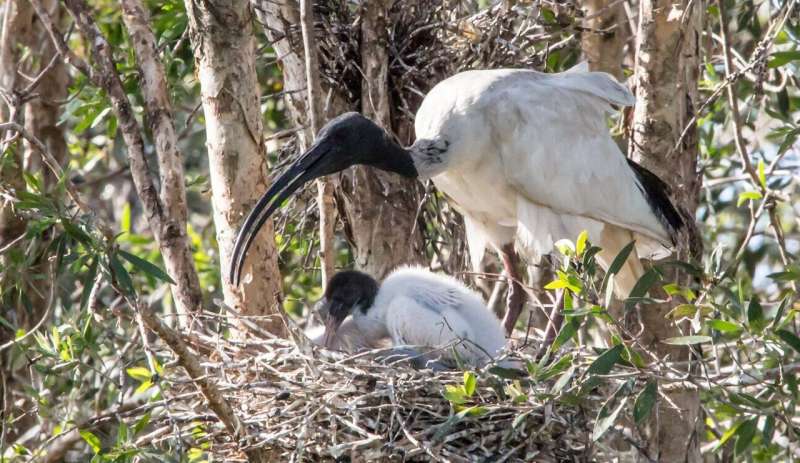This article has been reviewed according to Science X's editorial process and policies. Editors have highlighted the following attributes while ensuring the content's credibility:
fact-checked
trusted source
proofread
Finding the happy place of the ibis

University of the Sunshine Coast researchers have confirmed the happy place of one of Australia's smelliest and messiest native birds—the white ibis—and as expected, the closer to rubbish dumps the better.
It is one of many insights uncovered as part of a new study to better understand the bold scavenger who has taken over urban streets, parks and dumps across cities and towns across eastern Australia.
Identifying the favorite haunts of the birds—and why they choose them—may help to find more effective ways to discourage the birds from nesting in areas they are not wanted, according to findings published in the journal Urban Ecosystems.
"It seems modifying or reducing access to their preferred habitats could be a tool to managing this protected but nuisance species," said co-author UniSC Senior Lecturer in Animal Ecology Dr. Dominique Potvin.
The study found the birds do not like to nest at waste management facilities, but they do like to roost and breed close by, with proximity to these sites the major driver.
"Surprisingly, considering how many ibis choose to live near people and enjoy the benefits of scavenging their rubbish, our study found they still prefer to nest in locations with some buffering from people," Dr. Potvin said.
Ibis and their nests were most abundant at sites within 10 km of waste management facilities, and while nest numbers increased the closer to residential or industrial estates, they decreased the further away from 'rubbish tips."
"The findings highlight the need to focus on both foraging and nesting/roosting sites, and minimizing the proximity between them, rather than the current preferred form of solely managing nesting colonies through measures that include egg destruction," Dr. Potvin said.
Nirvana is an ibis island
The research team surveyed 26 colonies in the Moreton Bay region for the study and used a decade of historical data collected by the Council on local populations.
The bird's ideal place is a waterbound island with a high tree density. It does not like the trees it roosts in to be too high—less than 10 meters is best.
It also prefers where there are fewer tree species and may also have a fondness for eucalypts and melaleuca.
Keeping unwanted 'pests' out of the neighborhood
Lead author Caitlin Willis, who is studying the ibis as part of her UniSC doctoral studies, said this understanding may be useful in guiding urban planning, prioritizing interventions for specific sites and identifying future locations where the pest species might colonize.
"To help shift colonies from more urbanized areas and parklands, stakeholders could improve waste management facility policies in ibis reduction plans, especially reducing the amount and accessibility of available onsite refuse," she said.
"There needs to be careful consideration given to the trees that are being planted in parklands and other urban landscapes, especially if located near foraging grounds.
"To deter large colonies, the solution could be to make green spaces less attractive, with less desirable space, by planting a diverse range of taller trees in low densities within parklands and urban areas."
It is time to rethink a growing urban planning trend to place development near wetlands to allow access to walking tracks, fishing, and water sports, according to the research team.
Instead, wetlands may offer a way to create an 'ibis nirvana' to entice nesting colonies away from urban areas.
Co-author Dr. Ben Gilby said this would involve creating or managing wetland areas to maximize suitable nesting conditions, buffering from humans and increased protection from predators.
"As their native inland habitats have declined over the past three decades, they've established large permanent and seasonal nesting colonies in urban coastal areas, sometimes numbering hundreds of nests and thousands of individuals," said the UniSC Associate Professor in Animal Ecology.
"As well as complaints about their noise and odor, and even stealing food from humans, nesting colonies can degrade habitats, smother vegetation, cause erosion, pollute waterways and compete with native species for space.
"Few management interventions have so far been successful, and that's why this research project to better understand the conditions driving ibis habitat selection is so important."
More information: Caitlin S. Willis et al, Landscape and habitat characteristics jointly drive the urban distribution of a nuisance species, Urban Ecosystems (2024). DOI: 10.1007/s11252-024-01594-2
Provided by University of the Sunshine Coast




















